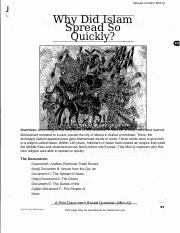This document sheds light on how Islam spread rapidly through trade routes and military conquests. Through detailed accounts of early Islamic expansion, it reveals strategic alliances and effective leadership as key drivers. By examining the document’s insights, we can grasp the political and social dynamics that shaped Islam’s swift dissemination. Let’s delve into the historical nuances to understand how this document explains how Islam spread so quickly.
How Does This Document Explain How Islam Spread So Quickly?
Welcome, young historians! Today, we are going to embark on a fascinating journey through history to uncover the secrets behind the rapid spread of Islam in its early days. By examining historical documents and accounts, we can gain insights into the factors that contributed to Islam’s swift expansion. So, let’s dive in and explore how this document sheds light on the remarkable spread of Islam!
The Rise of Islam
Before we delve into how Islam spread quickly, let’s take a moment to understand the beginnings of this influential faith. Islam emerged in the Arabian Peninsula in the 7th century, when the Prophet Muhammad began receiving revelations from Allah. These revelations were compiled into the holy book of Islam, the Quran, which served as a guide for Muslims.
Documenting the Spread
One crucial aspect of understanding how Islam spread rapidly is by examining historical documents from that era. These documents provide us with firsthand accounts of the events and movements that shaped the expansion of Islam. They offer valuable insights into the strategies, motivations, and challenges faced by early Muslim communities as they spread their faith.
The Role of Trade Routes
One key factor that contributed to the quick spread of Islam was the extensive network of trade routes that crisscrossed the Arabian Peninsula and beyond. Merchants and traders played a vital role in introducing Islam to different regions, as they traveled far and wide, carrying not only goods but also ideas and beliefs.
By engaging with people from diverse cultures and backgrounds, these traders served as conduits for the exchange of information about Islam. Through their interactions, they spread the teachings of Islam to new territories, paving the way for the religion to take root and flourish.
Political Alliances and Conquests
Another significant factor that fueled the rapid spread of Islam was the formation of political alliances and successful military conquests. In the early years of Islam, Muslim rulers strategically formed alliances with tribes and leaders, gaining support and protection for their communities.
These alliances not only helped to secure the safety of Muslim populations but also facilitated the spread of Islam through diplomatic channels. Additionally, the military conquests led by Muslim armies expanded the boundaries of the Islamic empire, bringing new territories and populations under the rule of Islam.
Social and Cultural Influences
Beyond trade and politics, social and cultural influences also played a significant role in the spread of Islam. The teachings of Islam, which emphasized unity, equality, and compassion, resonated with people from various backgrounds, attracting them to the faith.
Moreover, the establishment of vibrant Muslim communities in different regions served as centers of learning and cultural exchange. These communities fostered intellectual growth, artistic development, and scientific innovation, attracting individuals seeking knowledge and enlightenment.
As we conclude our exploration of how this document explains how Islam spread so quickly, we have gained a deeper understanding of the multifaceted factors that contributed to the rapid expansion of Islam in its early days. By examining historical documents and accounts, we have uncovered the pivotal roles played by trade routes, political alliances, and social influences in spreading the teachings of Islam far and wide.
Remember, young historians, history is like a puzzle waiting to be solved, with each piece offering a glimpse into the past. By studying the past, we can unravel the mysteries of how religions, cultures, and civilizations have evolved over time. So, keep exploring, keep questioning, and keep learning!
How Does This Document Explain How Islam Spread So Quickly? – Middle East Explorers
Frequently Asked Questions
How did Islam spread rapidly according to the document?
The document explains that Islam spread quickly due to a combination of military conquests, trade networks, and the appeal of its message to various communities. The expansion of the Islamic empire through military campaigns played a significant role in the spread of Islam across different regions.
What factors contributed to the swift expansion of Islam as detailed in the document?
The document highlights that the strategic location of trade routes, such as the Silk Road, facilitated the spread of Islam through commercial interactions and cultural exchanges. Additionally, the document emphasizes the efforts of early Muslim scholars and missionaries in spreading the teachings of Islam to diverse populations.
How did the document explain the influence of cultural contacts on the rapid dissemination of Islam?
According to the document, the interactions between Islamic societies and other civilizations played a crucial role in the rapid spread of Islam. Cultural exchanges and intellectual dialogues helped promote the acceptance of Islamic ideas and practices among different communities.
Final Thoughts
This document sheds light on how Islam spread quickly through trade routes, political conquests, and social interactions. The strategic location of Mecca as a trade center allowed for the dissemination of Islamic ideas. Military campaigns expanded Islamic territories, enforcing the religion upon conquered regions. Additionally, the appeal of Islamic beliefs and practices attracted diverse populations, contributing to its rapid spread. Overall, this document offers insights into how Islam spread so quickly.

